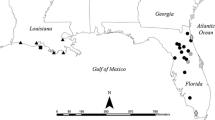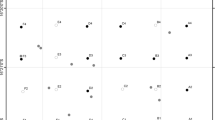Abstract
Individual generalist predators often have more specialized diets than their populations do. Individual specialization (IS) is influenced by ecological opportunity, intraspecific competition, and interspecific competition, although the effects of these parameters are inconsistent across studies. We investigated IS in five species of frogs and toads, Anaxyrus americanus, A. fowleri, Lithobates catesbeianus, L. clamitans, and L. sphenocephalus. We used the natural history and ecology of each species to predict which parameters would influence IS. Our predictions were supported for some species but not others. We predicted IS would be positively influenced by resource diversity in all species, but this prediction held for only three species, with the relationship significant in A. fowleri and L. catesbeianus and marginally significant in A. americanus. We also predicted that interspecific competition would have a negative relationship with IS in L. clamitans because L. catesbeianus is competitively superior to L. clamitans and likely to suppress its foraging options. This prediction was upheld. Finally, we predicted that IS in A. americanus, A. fowleri, and L. clamitans would be influenced by intraspecific competition. However, IS was not influenced by intraspecific competition in any species, a surprising result given that intraspecific competition has traditionally been assumed to be the ecological parameter with the strongest effects on IS. Many previous studies did not simultaneously consider all three ecological parameters, which may have increased the apparent importance of intraspecific competition for IS. Our results revealed that the ecological parameters affected IS differently even across closely related and ecologically similar species, and demonstrated that these differences are sometimes predictable based on natural history. This study also suggests that sympatric ecological speciation based on IS may be rare because the ecological parameters driving IS are inconsistent across species, and the strength of their effects on intraspecific diet variation varies in space.






Similar content being viewed by others
References
Abbey-Lee RN, Gaiser EE, Trexler JC (2013) Relative roles of dispersal dynamics and competition in determining the isotopic niche breadth of a wetland fish. Freshw Biol 58:780–792
Araújo MS, Bolnick DI, Layman CA (2011) The ecological causes of individual specialisation. Ecol Lett 14:948–958
Bearhop S, Adams CE, Waldron S et al (2004) Determining trophic niche width: a novel approach using stable isotope analysis. J Anim Ecol 73:1007–1012
Bolnick DI, Yang LH, Fordyce JA et al (2002) Measuring individual-level resource specialization. Ecology 83:2936–2941
Bolnick DI, Svanbäck R, Fordyce JA et al (2003) The ecology of individuals: incidence and implications of individual specialization. Am Nat 161:1–28
Bolnick DI, Svanbäck R, Araújo MS et al (2007) Comparative support for the niche variation hypothesis that more generalized populations are also more heterogeneous. Proc Natl Acad Sci USA 104:10075–10079
Bolnick DI, Ingram T, Stutz WE et al (2010) Ecological release from interspecific competition leads to decoupled changes in population and individual niche width. Proc R Soc 277:1789–1797
Bolnick DI, Amarasekare P, Araújo MS et al (2011) Why intraspecific trait variation matters in ecology. Trends Ecol Evol 26:183–192
Burnham KP, Anderson DR (2002) Model selection and multimodel inference: a practical information-theoretic approach. Springer, New York
Bury RB, Whelan JA (1986) Ecology and management of the bullfrog. US Department of the Interior, Fish and Wildlife Service. Resource publication 155, Washington
Bush FM (1959) Foods of some Kentucky herptiles. Herpetologica 15:73–77
Chamberlain CP, Waldbauer JR, Fox-Dobbs K et al (2005) Pleistocene to recent dietary shifts in California condors. Proc Natl Acad Sci USA 102:16707–16711
Cloyed CS (2015) The evolution and ecology of individual specializations amongst a group of dietary generalist. Electronic theses and dissertations paper 2105
Cloyed CS, Newsome SD, Eason PK (2015) Trophic discrimination factors and isotopic incorporation rates of carbon and nitrogen stable isotopes in adult green frogs, Lithobates clamitans. Physiol Biochem Zool 88:576–585
Costa GC, Mesquita DO, Colli GR et al (2008) Niche expansion and the niche variation hypothesis: does the degree of individual variation increase in depauperate assemblages? Am Nat 172:868–877
Coyne JA, Price TD (2000) Little evidence for sympatric speciation in island birds. Evolution 54:2166–2171
Crawford JA, Shepard DB, Conner CA (2009) Diet composition and overlap between recently metamorphosed Rana areolata and Rana sphenocephala: implications for a frog of conservation concern. Copeia 4:642–646
Darimont CT, Paquet PC, Reimchen TE (2009) Landscape heterogeneity and marine subsidy generate extensive intrapopulation niche diversity in a large terrestrial vertebrate. J Anim Ecol 78:126–133
Evangelista C, Boiche A, Lecerf A et al (2014) Ecological opportunities and intraspecific competition alter trophic niche specialization in an opportunistic stream predator. J Anim Ecol 83:1025–1034
Ewart JP (2004) Motion perception shapes the visual world of amphibians. In: Prete FR (ed) Complex worlds from simpler nervous systems. MIT Press, Cambridge, pp 117–160
Fitzpatrick BM, Turelli M (2006) The geography of mammalian speciation: mixed signals from phylogenies and range maps. Evolution 60:601–615
Forester DC, Snodgrass JW, Marsalek K et al (2006) Post-breeding dispersal and summer home range of female American toads (Bufos americanus). Northeast Nat 13:59–72
Graeter GJ, Rothermal BB, Gibbons JW (2008) Habitat selection and movement of pond-breeding amphibians in experimentally fragmented pine forests. J Wildl Manag 72:473–482
Hamilton WJ Jr (1954) The economic status of the toad. Herpetologica 10:37–40
Hecnar SJ, M’Closkey RT (1997) Changes in the composition of a ranid frog community following bullfrog extinction. Am Midl Nat 137:145–150
Homan RN, Atwood MA, Dunkle AJ et al (2010) Movement orientation by adult and juvenile wood frogs (Rana sylvatica) and American toads (Bufo americanus) over multiple years. Herpetol Conserv Biol 5:64–72
Johnson JB, Omland KS (2004) Model selection in ecology and evolution. Trends Ecol Evol 19:101–108
Jones AW, Post DM (2013) Consumer interaction strength may limit the diversifying effect of intraspecific competition: a test in alewife (Alosa pseudoharengus). Am Nat 181:815–826
Knudsen R, Primicerio R, Amundsen P et al (2010) Temporal stability of individual feeding specialization may promote speciation. J Anim Ecol 79:161–168
Lasky JR, Yang J, Zhang G et al (2014) The role of functional traits and individual variation in the co-occurrence of Ficus species. Ecology 95:978–990
Li Y, Ke Z, Wang Y et al (2011) Frog community responses to recent American bullfrog invasions. Curr Zool 57:83–92
Lichstein JW (2007) Intraspecific variation and species coexistence. Am Nat 170:807–818
Manly BFJ (2006) Randomization, bootstrap, and Monte Carlo methods in biology. CRC Press, London
Martin RA, Pfennig DW (2010) Field and experimental evidence that competition and ecological opportunity promote resource polymorphism. Biol J Linn Soc 100:3–88
Nosil P (2012) Ecological speciation. Oxford University Press, Oxford
Nosil P, Reimchen TE (2005) Ecological opportunity and levels of morphological variance within freshwater stickleback populations. Biol J Linn Soc 86:297–308
Parent CE, Crespi BJ (2009) Ecological opportunity in adaptive radiation of Galapagos endemic land snails. Am Nat 174:898–905
Parnell AC, Inger R, Bearhop S et al (2010) Source partitioning using stable isotopes: coping with too much variation. PLoS One 5:e9672
Pielou EC (1966) Shannon’s formula as a measure of species diversity: its use and misuse. Am Nat 100:463–465
Polito MJ, Trivelpiece WZ, Karnovsky NJ et al (2011) Integrating stomach content and stable isotope analyses to quantify the diets of pygoscelid penguins. PLoS One 6:e26642
Pyke GH, Pulliam HR, Charnov EL (1977) Optimal foraging: a selective review of theory and tests. Q Rev Biol 52:137–154
Quevedo M, Svanbäck R, Eklov P (2009) Intrapopulation niche partitioning in a generalist predator limits food web connectivity. Ecology 90:2263–2274
R Core Development Team (2015) R: a language and environment for statistical computing. R foundation for statistical computing, Vienna. http://www.R-project.org/
Robertson A, McDonald RA, Delahay RJ et al (2015) Resource availability affects individual niche variation and its consequences in group-living European badgers Meles meles. Oecologia 178:31–43
Rosenblatt AE, Heithaus MR (2011) Does variation in movement tactics and trophic interactions among American alligators create habitat linkages? J Anim Ecol 80:786–798
Rothermel BB, Semlitsch RD (2002) An experimental investigation of landscape resistance of forest versus old-field habitats to emigrating juvenile amphibians. Conserv Biol 16:1324–1332
Schindler DE, Hilborn R, Chasco B et al (2010) Population diversity and the portfolio effect in an exploited species. Nature 465:609–613
Schluter D (2000) The ecology of adaptive radiations. Oxford University Press, Oxford
Schluter D (2001) Ecology and the origin of species. Trends Ecol Evol 16:372–380
Solé MO et al (2005) Stomach-flushing for diet analysis in anurans: an improved protocol evaluated in a case study in Araucaria forests, southern Brazil. Stud Neotrop Fauna Environ 40:23–28
Stephens PA, Buskirk SW, Kwet AP et al (2005) Information theory and hypothesis testing: a call for pluralism. J Appl Ecol 42:4–12
Svanbäck R, Bolnick DI (2005) Intraspecific competition affects the strength of individual specialization: an optimal diet theory method. Evol Ecol Res 7:993–1012
Svanbäck R, Bolnick DI (2007) Intraspecific competition drives increased resource use diversity within a natural population. Proc R Soc 274:839–844
Tinker MT, Bentall G, Estes JA (2008) Food limitation leads to behavioral diversification and dietary specialization in sea otters. Proc Natl Acad Sci USA 105:560–565
Tinker TM, Guimarães PR Jr, Novak M et al (2012) Structure and mechanism of diet specialisation: testing models of individual variation in resource use with sea otters. Ecol Lett 15:475–483
Van Valen L (1965) Morphological variation and width of ecological niche. Am Nat 99:377–390
Wang Y, Guo Z, Pearl CA et al (2007) Body size affects the predatory interactions between introduced American Bullfrogs (Rana catesbeiana) and native anurans in China: an experimental study. J Herpetol 41:514–520
Wells KD (2007) The ecology and behavior of amphibians. University of Chicago Press, Chicago
Wennersten L, Forsman A (2012) Population-level consequences of polymorphisms, plasticity, and randomized phenotype switching: a review of predictions. Biol Rev Camb Phil Soc 87:756–767
Werner EE, Wellborn GA, McPeek MA (1995) Diet composition in postmetamorphic bullfrogs and green frogs: implications for interspecific predation and competition. J Herpetol 29:600–607
Acknowledgments
We thank two anonymous reviewers for their comments, which greatly improved the manuscript. Funding for this project came from Kentucky Society of Natural History and the University of Louisville College of Arts and Sciences.
Author information
Authors and Affiliations
Corresponding author
Electronic supplementary material
Below is the link to the electronic supplementary material.
Rights and permissions
About this article
Cite this article
Cloyed, C.S., Eason, P.K. Different ecological conditions support individual specialization in closely related, ecologically similar species. Evol Ecol 30, 379–400 (2016). https://doi.org/10.1007/s10682-016-9825-8
Received:
Accepted:
Published:
Issue Date:
DOI: https://doi.org/10.1007/s10682-016-9825-8




